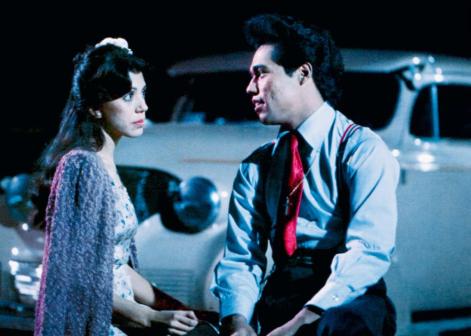Tags
1980s, Blogathon, Brecht, Creepy True Story, Crime, Drama, Epic Theatre, Movies with Cute Clothes, Musical, Politics, Racism
Dear Readers, To celebrate Hispanic Heritage Month (which is every month for me!) Aurora at Once Upon a Screen hosts Hollywood’s Hispanic Heritage Blogathon on October 12. It is an online event celebrating Hollywood’s great contributions from Hispanic Actors, Directors, Filmmakers, and Films! Visit Aurora and see the full blogging event. While you are there, do yourself a favor, follow her enjoyable blog. If you enjoy old-time radio theater her blog is the place for you, she curates old gems, like Vincent Price reading Three Skeleton Key!
Most people recognize Zoot Suits from the old Looney Tunes and Tom & Jerry cartoons, with an exaggerated high waist, baggy trousers with the over long loose fitting jackets.
Or you may have heard that song Zoot Suit Riot.
But if you grew up in Los Angeles, were Hispanic, and were in my grandmother’s generation, then the Zoot Suit Riots were a very violent and horrible event.
So for The Hispanic Heritage Blogathon, I chose a film offering Hispanic history and a film that speaks to my own heritage, as my grandmother and her family lived in Los Angeles at the time and had a front row seat to actual events.

That is my grandmother’s older sister, whom we call “Auntie Lucy”, my grandmother was hiding behind her in this photo.
When Zoot Suit begins, the narrator, “El Pachuco,” tells us the film is “a true incident, also a construct of fact and fantasy”.
The Real Story
On August 1, 1942, Hank Levya, a member of The 38th Street Gang, went out with his girlfriend, Dora Barrios. The Downey Street Gang (a rival gang) attacked Hank and his girlfriend, brutally beating them both.

ZOOT SUIT’s characters, loosely based on real people, the names and the details are different. From left, (Della) Rose Portillo & (Henry Reyna) Daniel Valdez, 1981, ©Universal
Later that evening, Hank and his friends returned to retaliate, unable to locate the Downey Street Gang they heard a party nearby and went there looking for Hank and Dora’s assailants. While the Downey Street Gang were not at the party, the result of the massive gate crash turned into a fight, and an innocent man Jose Diaz was killed.
Levya and 17 other young men were tried and convicted for Diaz’s murder. Meanwhile the City of Los Angeles responded with severe racial profiling, rounding up and randomly arrested “Zoot Suiters” including 600 Mexican American Men. Also targeted were Filipino and African American young men, just for wearing a Zoot Suit.

ZOOT SUIT, from left, Unknown (Sailor), Daniel Valdez (Henry), Edward James Olmos (El Pachuco) 1981, ©Universal
As the racial tension rose, random fights broke out on the streets of Los Angeles, the military began dragging “Zoot Suiters” into the streets, Zoot Suiters responded, the military responded, escalating violence. Riots broke out, as the military began attacking any remotely Latino looking individuals, no matter what they wore. Violence spread throughout the US sparking similar violence in Detroit, New York, Philadelphia. The riots continued until the Levya and his friends’ conviction was reversed.
About The Film
Luis Valdez’s Zoot Suit is Broadway’s first Chicano play written, performed, and directed by Chicanos.
If you recognize the name Luis Valdez, it is probably in conjunction with his film La Bamba (the Ritchie Valens story) but if you live in the Bay Area, (California) Valdez is synonymous with El Teatro Campesino. El Teatro Campesino located in San Juan Bautista, California (a small mission town, best known for Vertigo). For the past 50 years, Valdez and his ensemble troupe perform socio/political Chicano and Latino theater. Valdez’s unique bi-lingual style combines ‘actos’- or short skits, ‘mitos’- Mayan and Aztec Mythology, music, dance, and a lot of epic theatre.
The Plot
“El Pachuco” (Edward James Olmos), a nightclub entertainer, tells the story of Henry “Hank” Reyna (Daniel Valdez) a good kid about to join the Navy. While out on a date, the couple ends up at the wrong place at the wrong time. Hank and his friends are falsely accused of murdering a rival gang member, and held in prison waiting for a trial. The trial is clearly a joke, sparking riots. Meanwhile, the CIO sends Alice Bloomfield (Tyne Daly) a reporter who takes Hank’s story to the people. The government responds by releasing Hank and his friends.
The Trailer
Structure
To understand this film’s unusual structure, let’s examine the film through the lens of Bertolt Brecht and “Epic Theatre”. Brecht created a unique style of socio-political theater called “Epic Theatre”. Epic Theatre is one of the most influential movements in the 20th-century western theater. Epic theatre’s goal is not merely entertainment, it is to incite change, to draw attention to current social issues and inspire audiences to improve their lives. Zoot Suit demonstrates hallmarks of epic theatre. First, we have a single storyteller, “El Pachuco” (Edward James Olmos). He is our master of ceremonies, our storyteller, Hank’s alter-ego, the embodiment of the Pachuco.
Blocking
El Pachuco and Henry live in two separate worlds. El Pachuco exists in the night club, and Henry lives in the main story. Henry’s conversations with El Pachuco are outside the “world of the story”. When El Pachuco enters Henry’s realm, the other actors do not see him, often actors freeze or there is a significant lighting shift.
Zoot Suit was filmed on stage at The Aquarius Theatre in Los Angeles. We watch a play with minimal sets, we see lighting instruments, we see curtains, we see the audience, we are constantly aware this is a performance. Like Nine, Chicago, and Cabaret, Zoot Suit moves between representational and presentational styles.
By shifting back and forth between “reality” and “theatricality” the audience member must consider the story as it applies to their own lives.
Past Events/Present Issues
The film’s primary action centers around Henry Reyna, but it demonstrates the entire Chicano experience. Reyna is persecuted for his clothes, his friends, and his race. Not for his actions. He is the media’s pawn. The trial is delayed and the facts are misrepresented to sell newspapers.
Sadly, racial profiling is still a common occurrence. The film warns its audience, do not undertake an internal ethnic cleansing. Do not lose sight of your culture while trying to avoid such scenarios.
This is best exemplified in the ending when the entire company takes the “Pachuco Stance” and we hear several different endings of what becomes of Henry Reyna, signifying it is not his ending that counts, but our own, for we are all “Pachuco”.
This show features classic Pachuco Boogie music including the legendary Lalo Guerero, Here is a clip of Edward James Olmos singing Guerero’s song, Vamos a Bailar.
Critical Reception
Luis Valdez adapted and directed Zoot Suit to the screen in 1981. Zoot Suit received rave reviews in Los Angeles, The Hollywood Reporter described it as “infectious” and “buoyant” but The New York Times was less kind, Vincent Canby described it as a “holy mess of a movie”.
The film is written in Calo (which is combined Spanish and English), which may be off-putting as the Spanish words are not subtitled. But you do not have to be a Spanish speaker to enjoy the film, or understand the intent behind the Spanish words and phrases, the actors make the intent quite clear.
It also sheds some light on some early origins of the Chicano Movement (a less taught part of the Civil Rights movement), many important civil rights leaders were targeted during the Zoot Suit Riots including Ralph Ellison, Malcolm X, and Cesar Chavez!
While clearly a socio-political piece, Zoot Suit is extremely entertaining, featuring great swing dance numbers and fun songs (if you are a Grease fan, this film shares many background dancers. Also, Henry’s closest friends are the “T-Birds” that aren’t Jeff Conaway or John Travolta).
I think it is a great film and an underrated classic!
Don’t forget to visit Aurora and check out the rest of the event!
And mark you calendars:
Ciao for Now Dearies!
-Summer
Resources
American film Institue Entry: http://www.afi.com/members/catalog/DetailView.aspx?s=&Movie=56718
Vincent Canby NY Times: http://www.nytimes.com/movie/review?res=9D04EEDB103BF931A15752C0A964948260







A fascinating read – interesting history, backstory story and film review!! I’m thrilled you submitted this to the blogathon. THANK YOU!!
Aurora
LikeLiked by 1 person
Thank you for hosting such a cool event!
LikeLike
Pingback: ¡De Película! Hollywood’s Hispanic Heritage Blogathon | Once upon a screen…
I’ve always been a bit ignorant of the true story behind the zoot suit (I’m from the UK, it’s not exactly covered in our history classes) so thanks for bringing the historical context and for showcasing these two films – I look forward to watching them!
LikeLiked by 1 person
Actually, they do not teach much Chicano history in the US either, unless you take a Chicano History or Mexican American Studies.
Zoot Suit is a fantastic film, if you get a chance be sure to check it out. 🙂
LikeLike
Talk about an interesting story. I’d never heard of Zoot Suits. Thanks for sharing something personal to you especially the photo of your grandmother and aunt.
LikeLiked by 1 person
Thank you! It is an interesting little blip in history that is often overlooked but played a major role as a motivator for the civil rights movement 🙂
LikeLike
Muchas gracias for a very informative and well written post.
LikeLiked by 1 person
Por nada! And thank you for the wonderful compliment. 🙂
LikeLike
Thanks for the recommendation. I’ve not heard of this film, but will watch for it.
Also, thanks for including your research (your blog is making me a real Smarty Pants). And your grandmother and her sister were part of this history! How neat is that!
LikeLiked by 1 person
It is a unique film, if you get a chance to see, please let me know what you think! I am glad you enjoy the research elements, that is the fun part for me. 🙂
LikeLike
Great piece. I first learned about the Zoot Suit Riots in James Ellroy’s novel The Big Nowhere. The film sounds definitely worth a look.
LikeLiked by 1 person
Hi, Kelly!
Thank you very much!
I read some Ellroy, but not The Big Nowhere, I’ll have to look for it, his books are always a fun read.
Zoot Suit is really a unique film, I hope you get a chance to see it.
-Summer
LikeLike
I remember the movie being out but have never seen it. Like the way you blended in your personal history and true background with he film. Thanks!
LikeLiked by 1 person
Wow, what an interesting topic! The way you wrote made me think of a West Side Story situation narrated in a Book of Life fashion. Very intriguing, indeed!
Don’t forget to read my contribution to the blogathon! 🙂
Kisses!
Le
http://www.criticaretro.blogspot.com
And, oh, I’m thinking about a topic for your France in film blogathon. I’ll be back when I make up my mind.
LikeLiked by 1 person
Hi Le, Thanks!
I am so happy you are considering the France on Film Blogathon, it is shaping up to be a cool event! I will definitely check out your post, I am still working through the Hispanic Heritage event! 🙂 lots of great stuff to read!
-Summer
LikeLike